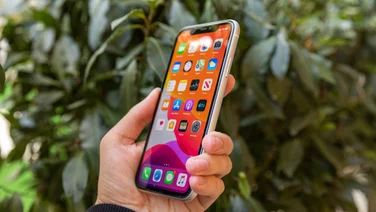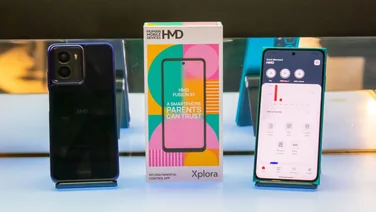To help us provide you with free impartial advice, we may earn a commission if you buy through links on our site. Learn more































- Better value than ever
- Unusual IP68 certification
- Improved camera performance
- Xiaomi’s software isn’t the best
- Curved screen won’t be for everyone
- Charging provision has regressed
In the affordable world of Xiaomi’s Poco sub-brand, the X-series occupies the middle ground. It might not offer the flagship-bothering performance of the speedy F-series but there’s still more scope to impress than the entry-level M-series.
On paper, the Poco X7 looks to be one of the more impressive additions to the budget smartphone roster, offering eye-catching features at a price that seems more aggressive than ever. Is this the best-specced phone for £250?
Xiaomi Poco X7 review: What you need to know
The Poco sub-brand has often punched above its weight on performance, and with the Poco X7 that means a MediaTek Dimensity 7300 Ultra processor that wouldn’t look out of place in a much pricier phone.
This is backed by either 8 or 12GB of RAM and a healthy 256GB of internal storage. There’s also a larger-than-average 5,110mAh battery.































We’ve come to expect a punchy 6.67in AMOLED display by now but this year’s model adds curved edges and a bolstered peak brightness into the equation. Don’t let that curvaceous design fool you, however – Xiaomi has covered the display with a tougher layer of Gorilla Glass Victus 2, while also giving the phone superior IP68 dust and water resistance.
READ NEXT: Best mid-range smartphone
Xiaomi Poco X7 review: Price and competition
At a time when everything seems to be getting more expensive, it’s genuinely heartening to report on a phone that’s actually cheaper than its immediate predecessor. With a starting price of £249, the Poco X7 undercuts the Poco X6 launch price by £70.Of course, the latter shipped with 12GB of RAM rather than the X7 starter model’s 8GB but even if you upgrade to the 12GB Poxo X7, it will still only cost you £299. At these prices, the Poco X7 is competing directly with the likes of the Motorola Moto G75 5G and the Samsung Galaxy A25 5G.
As ever with Xiaomi, there’s an early bird deal running that will get you the Poco X7 for £199 (8GB) and £249 (12GB) if you buy them in the first week of sale.
Xiaomi Poco X7 review: Design and key features
Xiaomi has taken a slightly different route with the Poco X7’s design this year. While the Poco X7 Pro is flat and purposeful, the non-Pro is much softer and curvier, with the formerly flat display now curving gracefully off to the sides.































It still gives a vaguely premium impression, even though the vast majority of flagship phones these days have flattened out. I prefer that flat approach from a purely practical perspective, which we’ll discuss shortly, but this is an undoubtedly good-looking handset from most angles.
The back of the phone doesn’t strike quite the same positive note, however, at least in the model I was sent. Both the Silver model reviewed here and the Green variant come with a slightly cheap-looking dappled faux-metallic design to its smooth plastic material, while the Black model gives you a nicer (and grippier) vegan leather finish. All three colours have a slightly tacky-looking Poco logo emblazoned in large lettering on the lower half.































Measuring 74 x 8.4 x 162mm (WDH) and weighing 186g, it’s on the more approachable side of average. You’ll pay a price for that vegan leather finish, though, with an extra 0.23mm added to the thickness and another 4.5g in weight.
It’s a somewhat mixed bag in the looks department, then, but there’s no questioning Xiaomi when it comes to build quality. This is an unusually tough phone for its price, with Corning Gorilla Glass Victus 2 protecting those exposed screen edges and IP68 certification holding off water and dust – both of which are pretty unique in the sub-£300 smartphone category.































There’s a responsive in-display fingerprint sensor around front, adequate stereo speakers flanking the display in landscape orientation and an IR blaster on the top edge. This is a curious but welcome quirk that you’ll often find in Xiaomi phones, allowing you to take control of your Hi-Fi or TV using the preinstalled Mi Remote app.
Xiaomi’s HyperOS might have received a name change in recent years, but it’s just as busy as ever, with stacks of bloatware and an overly fussy split notification menu. It’s running on top of Android 14, and it will only receive three major OS updates – one of which will be Android 15, which many other phones have already switched to – and four years of security updates.
Xiaomi Poco X7 review: Display
Xiaomi usually equips its Poco phones with strong displays and the X7 certainly lives up to that precedent. Like the Poco X6 before it, this is a 6.67″ AMOLED with a 120Hz refresh rate and a sharper-than-usual 1,220 x 2,712 (sometimes referred to as 1.5K) resolution.































There are a couple of fresh elements to the Poco X7 display, one of which we’ve mentioned already. It’s a dual curved screen, which means that it melts away into a recessed side frame. This looks great but it makes for a less uniform picture when playing full-screen movie and gaming content. It technically also opens the phone up to more false presses with your holding hand, though I didn’t find this to be particularly problematic.
Another unequivocally positive addition is the bolstered peak brightness. In general usage, it’s much the same as before, and I recorded a solid maximum brightness of 544cd/m² with auto-brightness switched off. There’s a much higher stated peak brightness of 3,000cd/m², however, which should be reflected in superior HDR performance in optimised media content.































In terms of colour accuracy, the Poco X7 display seems more tuned to the DCI-P3 colour space. Switching to the more natural sRGB screen mode, I recorded an sRGB gamut coverage of 94.6% against a volume of 98%, with a somewhat disappointing (though far from bad) average Delta E score of 2.3.
READ NEXT: Best phone camera
Xiaomi Poco X7 review: Performance and battery life
In all but the very cheapest of Poco phones, you can generally count on a level of performance that seems to come from a higher smartphone category. The Poco X7 keeps up this admirable tradition, thanks to its utilisation of the MediaTek Dimensity 7300 Ultra. You’ll find variations of this chip used in the £499 Oppo Reno 12 Pro 5G and the £399 Motorola Edge 50 Neo.
My Geekbench 6 tests reveal a phone that comfortably matches the Samsung Galaxy A35 5G and the Motorola Moto Edge 50 Fusion in the CPU performance stakes. Those are both phones that retail for around £100 more than the Poco X7. On the other hand, it doesn’t represent much of an improvement (if any) over the Poco X6 with its Snapdragon 7s Gen 2.

I was unable to run our usual GFX Bench tests to establish the Poco X7’s GPU prowess – as is often the case with Xiaomi phones, the tests wouldn’t load up on pre-launch hardware. However, I can state that in the 3D Mark Wild Life test, it scored similarly to the Moto G75 5G with its capable Snapdragon 6 Gen 3 chip. Practically speaking, Genshin Impact runs pretty well at medium graphical settings.
It’s good to see that Xiaomi has once again packed the Poco X7 with a 5,110mAh battery, which is a little larger than we’re used to seeing on budget phones. This results in a phone that managed to get me through a day of moderate usage (around 4hrs 20mins screen on time) with 54% left, promising genuine two-day usage.
Meanwhile, in our usual looping video test, the Poco X7 managed to last 24hrs 41mins. That’s not quite up there with the Motorola Edge 50 Fusion and the Nothing Phone (2a), but it is broadly a match for the Samsung Galaxy A35 5G.

It’s a bit of a shame to see Xiaomi rolling back the Poco X7’s charging capacity to 45W from the heady heights of 67W in the Poco X6. However, this will still get you from empty to full in about 50 minutes, which is far from terrible. You don’t get said charger in the box here in the UK, however. That’s a shame, though it’s far from unusual — Google, Motorola and Samsung also omit a charger from many of their phones.
READ NEXT: Best phone battery life
Xiaomi Poco X7 review: Cameras
Xiaomi has taken a notable step up with the Poco X7’s cameras, chiefly through an upgrade to a 50-megapixel Sony IMX 882 main sensor. That’s the same sensor that you’ll find in the £399 Poco F6, not to mention the concurrently released Poco X7 Pro.
Together with a wide f/1.5 aperture and OIS, this main camera is capable of capturing bright, sharp shots. Xiaomi’s colour science is a little on the vibrant side for my taste but many will love that extra pop and things never look too otherworldly. I did pick up hints of overexposure on one unusually sunny winter’s day where the sun was low but this was a particularly challenging scenario.

Portrait shots crop in effectively, providing generally decent subject separation and convincing bokeh, as well as nice natural skin tones. With no dedicated telephoto camera (the extra sensor is a pointless 2-megapixel macro), the Poco X7 crops in on that capable main sensor when you want to zoom in. 2x shots look decent (below) but everything from 4x upwards, topping out at 20x, gets increasingly soft.

Night shots betray the Poco X7’s budget status. They’re far from bad but you’ll notice the noise starting to encroach in those darker skies and a general fuzziness in places where even mid-range phones can pick details out with greater clarity.

That new main sensor is doing a lot of the hard work here, and the ultra-wide doesn’t help out much. The tone isn’t completely divorced, thanks to Xiaomi’s colour tuning chops, no doubt, but images get very soft towards the edges. The 20-megapixel front camera is perfectly adequate for the price, just so long as you keep away from that awful beautifying effect.

Video quality is crisp and clear at 4K/30fps or 1080p/60fps, with OIS working to steady things nicely. I did pick up quite a bit of wind noise on one particularly windy day but that’s not unusual even in more expensive phones.
Xiaomi Poco X7 review: Verdict
The Poco X7 represents excellent value for money. Not only has Xiaomi provided improvements in build and camera quality compared to previous models, it’s managed to do so while lowering the asking price.
Battery life, performance and display quality remain competitive with rival phones and, while it’s a shame to note that charging speed has gotten a little worse this time around, you still get a decent 45W plug in the box.
If there’s one lingering concern it’s that Xiaomi continues to lag behind on the software front, with a fussy UI and a mediocre update promise. The competition from Motorola and Samsung have much to recommend them on this front, among others. However, the Poco X7 has the hardware chops and aggressive pricing to keep it in the mix.




